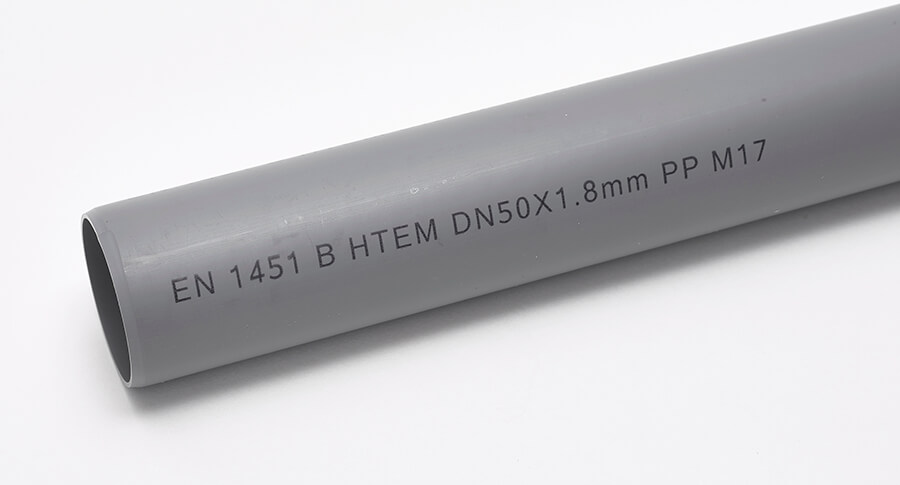How to choose the right inkjet coding solution for pipes and plastics manufacturing
Clear and durable marking and coding are critical for pipes and plastics manufacturers. Customers rely on identifying marks on pipes and plastics to ensure the right size and material type is used in specific applications, and marks play an important role in manufacturing for product traceability, quality assurance and more.
Challenges of marking on pipes and plastics
One of the bigger challenges when marking pipes and plastics is achieving the required print quality and mark durability.
Marks and codes on pipes and plastics need to be crisp and high contrast, with ink that stands the test of time. With pipes, especially, we’re talking about products that may be in place for decades and possibly exposed to a variety of harsh elements, such as fluctuating temperatures, humidity, dust, chemicals, and fluids.
Other notable pipes and plastics marking challenges include:
- Non-temperature-controlled production environments
- Dust, vibration, surface contaminants
- Non-stop operation – reliability is must
- High line speeds
- Integration with PLC and other shop/warehouse systems
- Variety of materials and dimensions
- Cost sensitivity

High temp ink steel pipe marking
Choosing the right inkjet printer for your needs
It’s rarely one size fits all in pipe, plastics and tubing manufacturing. To ensure you choose the right inkjet printer for your unique needs, follow these steps:
Step 1. Treat every substrate differently
Will you be printing on metal or plastic tubing? What types of plastics will you mark on? What type of metals? Are there special coatings? Significant chemical and physical differences between plastics, even within the same polymer family, often mean you cannot always print on all materials with the same print technologies and inks. Metal surface can also vary, and there may be considerations like heat and oil contamination.
Also consider:
- How dark are the products, and what does this mean for the required ink contrast?
- What are the dimensions, and what does this mean for mark size?

Plastic pipe coding and marking example.
Step 2. Determine the required print speed and resolution
Different types and models of inkjet printers have different capabilities when it comes to print speed and resolution. Matthews V-Series DOD valvejet printers are the most reliable in the industry for high-speed large-character pipe marking. With the V-Series, you can mark in big, bold alphanumeric characters without missing a beat. For high-resolution and smaller character applications, Matthews L-Series TIJ printers deliver up to 600 dpi resolution and support for high-speed operation.
Step 3. Choose a compatible ink
You need ink compatible with the materials you will be marking, and that meets your durability and legibility requirements. For example, a steel pipe and tubing manufacturer found that black ink had a limited contrast against different steel substrates, making legibility a challenge in specific applications. However, white ink ensures that all marks have clear contrast and are highly legible (both by customers and imaging devices) against any dark steel substrate.
Another consideration is UV exposure. Fading in sunlight can be a major concern for print durability for pipes and plastics. Therefore, you need ink with good fade resistance.
Matthews can test inks as part of a complete solution with the Matthews print technology best suited for your application.
Step 4. Determine if you need custom mounts
Now that you have the essentials covered, consider any additional features you might need to integrate the printer into your line. Closely examine your machinery to locate the best place to mount print heads. Can the print head simply mount on the side of conveyor in a fixed location, or do you need something more elaborate?
For instance, do you need traversing systems to move printheads into large pipes to mark the interior surface? Or the ability to raise and lower print heads to suit varying thicknesses of steel or plastic? Do you have limited space requirements?
In each of these scenarios, a solution can be created that will match up with your requirements and lead to more efficient and reliable operation.
Step 5. Consider how to integrate the printer into your operation
Investing in a universal controller can bring huge benefits in efficiency by enabling you to centrally manage print operations, allowing for fast and seamless changeovers.
For example, Matthews’ marking and coding automation platform, MPERIA, can both control all your printers across multiple lines and integrate with scanners and other equipment to verify mark accuracy. Workers can easily select or edit marks and codes line-side as products change, or you can manage the entire process from a central location.
You can also automate marking processes fully with integration to ERP, PLC and other back office and shop control systems.

Never compromise on your pipes and plastics marking
Inkjet printers are a cost-effective and reliable solution for pipe and plastics marking, giving you clear and precise marks that will last long into the future.
But even with inkjet printers, there’s no one-size-fits-all solution. The key to choosing the right pipes and plastics marking solution is taking the time to determine what you need, then working with the experts to find the best-fit solution.
When you work with Matthews, you don’t need to compromise on your marking solution. We’ve seen it all, and our engineering experts can customize our technologies and inks to fit your specifications — not the other way around.
Fill out the quick form below to talk to one of our experts.
